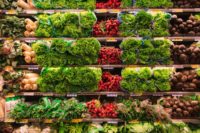The COVID-19 pandemic has affected nearly every aspect of our lives, as well as virtually every industry on Earth. For starters, we’ve seen numerous disruptions to the food supply chain, in addition to increased reports of contaminated meat and poor working conditions in factory farms.
Although the meatpacking industry has experienced its fair share of contamination problems in the wake of COVID-19, the U.S. agricultural system is far from exempt from this type of issue. According to the Centers for Disease Control and Prevention (CDC), food can become contaminated in many ways. Contaminated water used in irrigation and washing, for example, can harm raw fruits and vegetables well before harvest, rendering them inedible.
Food contamination can also occur in the production, distribution, storage, and processing stages. As such, every level of the food production chain must be aware of potential contamination risks, and agricultural companies should also do their part to reduce workplace hazards. Let’s take a look at common culprits, and explore the role of agricultural workers in helping to eliminate food contamination across the industry.
Potential sources of food contamination
On the surface, the risk of food poisoning may seem like somewhat of a non-issue as the world continues to adapt to a global pandemic of unprecedented proportions. But it would be a mistake to overlook the dangers of foodborne pathogens, which can be deadly. An estimated 9.4 million people are sickened by contaminated food every year, with 1,351 deaths also attributed to foodborne illness.
Common foodborne illnesses include salmonella, staph, and E. coli. Symptoms may include nausea, dizziness, and vomiting, and many of those who contract a foodborne illness ultimately consult with a medical professional. With the nation’s medical facilities under continued strain from COVID-19, reducing foodborne illness has become even more relevant. Fewer instances of food poisoning help keep clinics and emergency rooms from becoming overwhelmed with patients.
Unfortunately, the potential sources of food contamination can vary widely. And many, such as contaminated irrigation water, may not even be discovered until that food product reaches consumers. By then, it’s typically far too late to do anything about the contaminant. In these cases, a recall of the contaminated food is likely to be issued, and the general public made aware of the incident.
From field to consumer: cleaning up the supply chain
Food safety begins in the fields, with the workers who cultivate and harvest the crops that ultimately end up in the supermarket, and ends with the consumer. Errors and poor hygiene by home chefs is also a major culprit in regards to food contamination. Those preparing meals at home should be especially vigilant about food safety protocols, from consistent handwashing to regularly disinfecting food preparation areas.
Similar protocols should be followed within agriculture process centers, as cleaning is widely considered crucial to the contamination control process. Home chefs and agriculture workers alike can use third-party food contact surface wipes to help eliminate food contamination risks. Face masks and sterile gloves should also be worn by anyone who comes in contact with food, on every level of the supply chain.
And make no mistake: Food contamination is both a public health issue and a social one. Poor working conditions for agricultural workers equate yet another potential source of foodborne illness. What’s more, a significant chunk of America’s agricultural labor force is immigrants, who may be largely silent in regards to human rights and their own wellbeing.
Promoting worker rights and eliminating workplace hazards
According to legal experts, foreign-born workers are a vital part of the food production process. Nearly three-fourths of the nation’s agricultural workers were born outside the U.S., and nearly half of these workers do not have legal citizenship or hold a green card. Immigrant workers perform a wide variety of duties within American agriculture, including harvesting, maintaining livestock, planting and fertilizing, and more.
For undocumented workers, a food contamination event can have wide-reaching repercussions. As an example, if a particular crop or agricultural product is found to be contaminated, officials investigating the incident may also decide to contact immigration authorities. In turn, undocumented workers, who may also have been directly exposed to contaminated food, are likely to be deported.
Mass deportations can effectively bring the supply chain to a standstill, severely impacting an agricultural company’s bottom line. By working to eliminate potential sources of food contamination within facilities, as well as improving worker conditions, companies may be able to mitigate some of the damage before it occurs. What’s more, a food contamination incident can negatively impact a company’s reputation well into the future, and it can be difficult to recover from that type of fallout.
Key takeaways
It’s important to note that potential food contamination can occur on large-scale farms and small, family operations alike. Even production methods that are widely regarded as sustainable, such as the farm-to-table model, aren’t immune to workplace hazards and food contamination. The good news is that the consistent cleaning of surfaces and regular testing of crop irrigation water can help to eliminate potential risks, improving the safety and health of agricultural workers and consumers well into the future.



